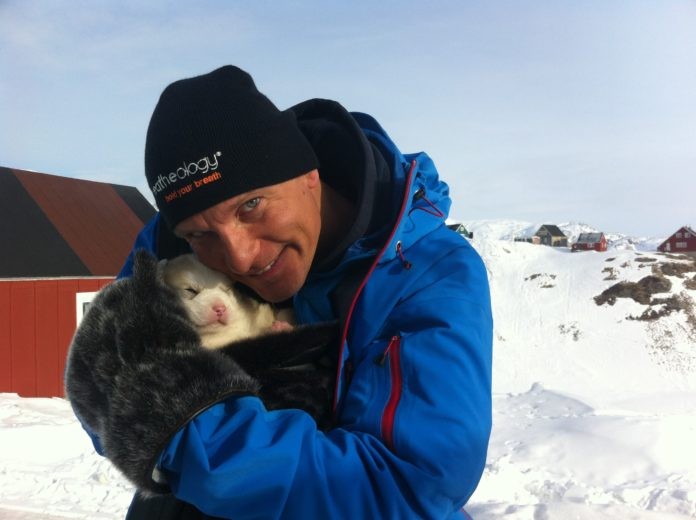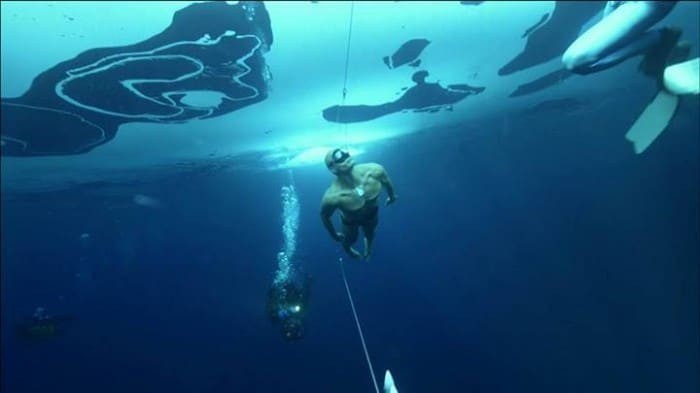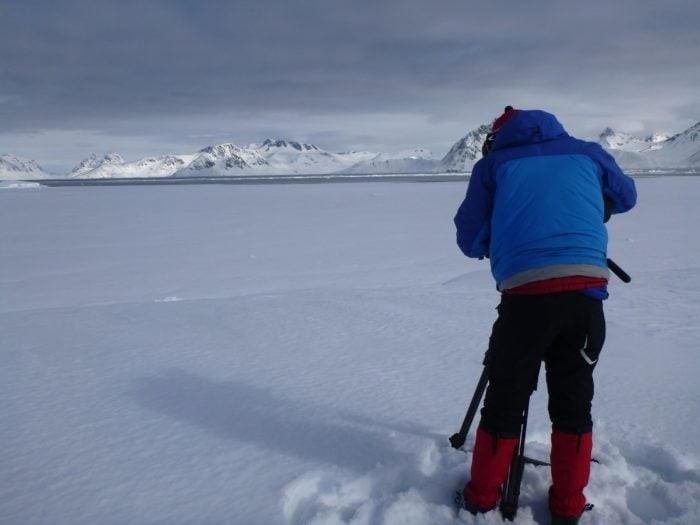Multiple-time Danish World Champion freediver Stig Severinsen last week achieved a new Guinness World Record by swimming 250 feet (76.2 meters) underwater — without fins or even a wetsuit — below one-meter-thick ice on a single breath of air.
In the days following his feat, Severinsen was kind enough to answer a few questions from DeeperBlue.com about his dive:
DEEPERBLUE.COM: Obviously swimming in frigid water without a wetsuit presents a unique set of challenges, no? Was your mental/physical preparation for this latest swim any different from the 500-ft record with fins, and if so, what did it entail?
STIG SEVERINSEN: Yes – obviously these two disciplines are very different from each other. The mental preparation has come to play a larger and larger role for me in the last few years. I draw on a long life of experience and do not need to train as much physically as I did before. Once I set a goal I live that goal everyday – almost like an obsession. I am very good at cutting away other things in life such as shopping, girlfriends, drinking, etc… – not to say that this is only a positive thing but it keeps me on a laser-sharp track. When my goal becomes a natural part of me I know I can accomplish the dive. The rest is just physics — training in the breaststroke.
I love this style and was a competitive swimmer in my younger years — specialized in breast stroke. I really love to swim this way: “froggy style.”
However, the way you swim underwater is quite distinct from how you swim on the surface. I have developed a lot of this technique myself — especially during and after my first official world record of 166 meters in Dynamic Without Fins (DNF) back in 2003.
The Guinness World Record regulations do not allow for a swimcap nor grease on the body to stay warm. Since I have a bald head (or closely shaved) the icy cold is very intense. Since I am also not allowed to wear a neck weight the diving is much more difficult and I cannot pack too much for the dive. In Denmark, Norway and Finland I train naked and get used to the ice waters. Especially in my hometown where we have a Viking Club; here I train in the winter and every season I feel like “Holy s**t…that IS cold….how will I ever manage to not cramp up or freak out after 5 seconds?” But then I just built my mental and physical stamina and get ready.
DB: What changes, if any, were made on the safety side? (more/fewer divers, hypothermia mitigation preparations, etc)
SS: Actually this dive could have gone quite wrong because the water was so cold that the upper line for my custom-made Breatheology lanyard nearly froze into the ice roof! If the safety divers had not noticed this and freed the line it would not have been funny at all. Getting stuck almost naked under 3 feet of ice after something like 220 feet is no joke!
The under water scooter also had problems keeping up with me during my monofinswim (500 feet) – especially since the last dive gear had frozen – it was that damn cold! So for the “Speedo dive” we used oil to keep it smooth and functional.
Also I was concerned about swimming to far — when I am “deep” into the dive (inside myself – it feels like nearly sleeping…I call it “meditation under water”) then I could have swum passed the last ice hole. So we had agreed that the last safety diver should block me if that happened. We also knew it was paramount NOT to be cold beforehand — so no test dive was done. I did that on the 500-feet dive and because a storm was coming so I decided to dive shortly after (for the 500 ft world record). That was a very tough dive…all the equipment was frozen – and I was tired, cold and dehydrated before the start, so not really optimal. SO – for the Speedo dive I was better prepared and the dive went really well.
DB: If you were to break down the swim in stages, what was the first 50 feet like? The second 50 feet, etc? Or did you plan it differently? Were there any surprises during the swim?
SS: I don’t really have too many “stages” in my mind. I know that once I start the dive I cannot stop. There is only one solution – getting to that last hole. There are another few holes on the way (for safety and photography – also as safety for the SCUBA-divers) but I do not think about these so in a sense they do not exist in my mind. They are not an option!
But before the dive I do my Breatheology breathing and mind exercises – get into that “right place” – smile, make fun with my sidekick Bøf (my coach/cat) and try to have fun with people. Then the last 2 minutes I focus and feel ready. I put my leg into the water to feel the stunning pain and soon after I do not notice the coldness anymore. When I dive in of course it is a big shock for the entire organism, but I am already shutting down those sensory signals. I have to be careful not to cut myself since the ice is razor sharp and then I have to find the best possible depth for buoyancy.
I really try to enjoy this moment and live it fully. I almost fall asleep and do not have my sensory system fire up like it normally would. On these record dive I become someone else – almost! That is what it feels like.
The last part is the most dangerous because I have used most of my oxygen and also my body is so cold and numb it becomes more difficult to move. My brain is sending signals to the muscles – but they do not respond as well.
Mentally it is all about being able to relax, accept and enjoy. Adding the immense stress of also shooting for Discovery Channel – this time even for my own program series, did not make things easier. I was even an Associate Producer this time, so there were a lot of things on my mind. But again – once I dive, I dive and forget about anything else. That is the beauty of these dives – the ultimate freedom!
DB: How long did it take to set up the course? What lessons learned from the 500-foot swim did you apply to last week’s event?
SS: Ohhh – setting up the course and cutting though that thick hard ice could have been own entire program on Discovery Channel. The got tremendous help from the locals in Tasiilaq. Without them we would have needed many months to set up the course! It was 3 days of hard intense work and I worked my little butt off as well. I know a lot of people (especially outside of freediving) cannot comprehend how or why freedivers are always so entangled in the records logistics. But it is simply just the way it is. We need to oversee and adjust everything. I have seen this so many times — with Carlos Coste, Herbert Nitsch and many other great freediving friends. Those are just the bare facts! If we had millions of dollars in support or sponsor aid or a team of 120 people than things would look differently. But this “getting your fingers dirty” approach is also what makes it fun – and finally a great challenge!
DB: Did you have DNA tests and blood/urine samples taken before and after the swim? Were there some interesting numbers from those tests that you would be willing to share?
SS: Yes. For several months I collaborated with Nordic Laboratories – an independent clinic in Copenhagen which is on the forefront of health and performance gene testing. They use a number of the best testing kits and analysis laboratories around the world so I really got a lot of data. It will be too laborious to go into details here, but one gene for regenerative power (like after a hard training/recovery) indicated that I was over 60% better to do this than the average person. Meaning I can train much harder for longer – but also recover very quickly and perform again.
We collected urine and blood samples 5 times a day to follow the variation over 24 hours – and even collected just before and after the dives. The most interesting finding was my ability to adapt to a stressful situation and a stressful environment…and maybe most interestingly my ability to stay calm – even during the dive. The thing that triggered the highest stress-response in me was actually the uncertainty of the dive being possible the day fore the record attempt because a storm was moving in and because the holes had not been finished – everything takes much longer than you anticipate in Greenland – it is a rough place.
Many thanks again to Stig for sharing his experience with DeeperBlue.com.
[youtube http://www.youtube.com/watch?v=b-Mr1RV3Qxc]





